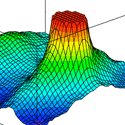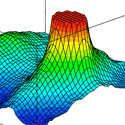A melting pot of protons
The quark-gluon plasma—a fluidlike novel state of matter—is one of the most exciting phenomena to emerge out of studies of heavy-ion collisions at relativistic energies. Many basic questions about this state of matter remain unanswered and are the subject of intense experimental and theoretical scrutiny worldwide. For example, can the quark-gluon plasma also be obtained from the collisions of smaller particles, such as protons? If so, at what energies do these collisions need to occur?
In a paper appearing in Physical Review Letters, Klaus Werner at the University of Nantes, France, and collaborators present numerical simulations that suggest that some of the key features in the data on proton-proton collisions at , obtained from recent experiments at CERN’s Large Hadron Collider (LHC), are consistent with the formation of a fluid phase of matter. According to the authors, proton collisions seem to result in a quark-gluon plasma as well, though the volume of the plasma is substantially smaller than that obtained in heavy-ion collisions. Their result is likely to inspire further theoretical investigations into the extreme state of matter that forms at the energies where experimental data is just about beginning to emerge from the LHC. – Abhishek Agarwal





